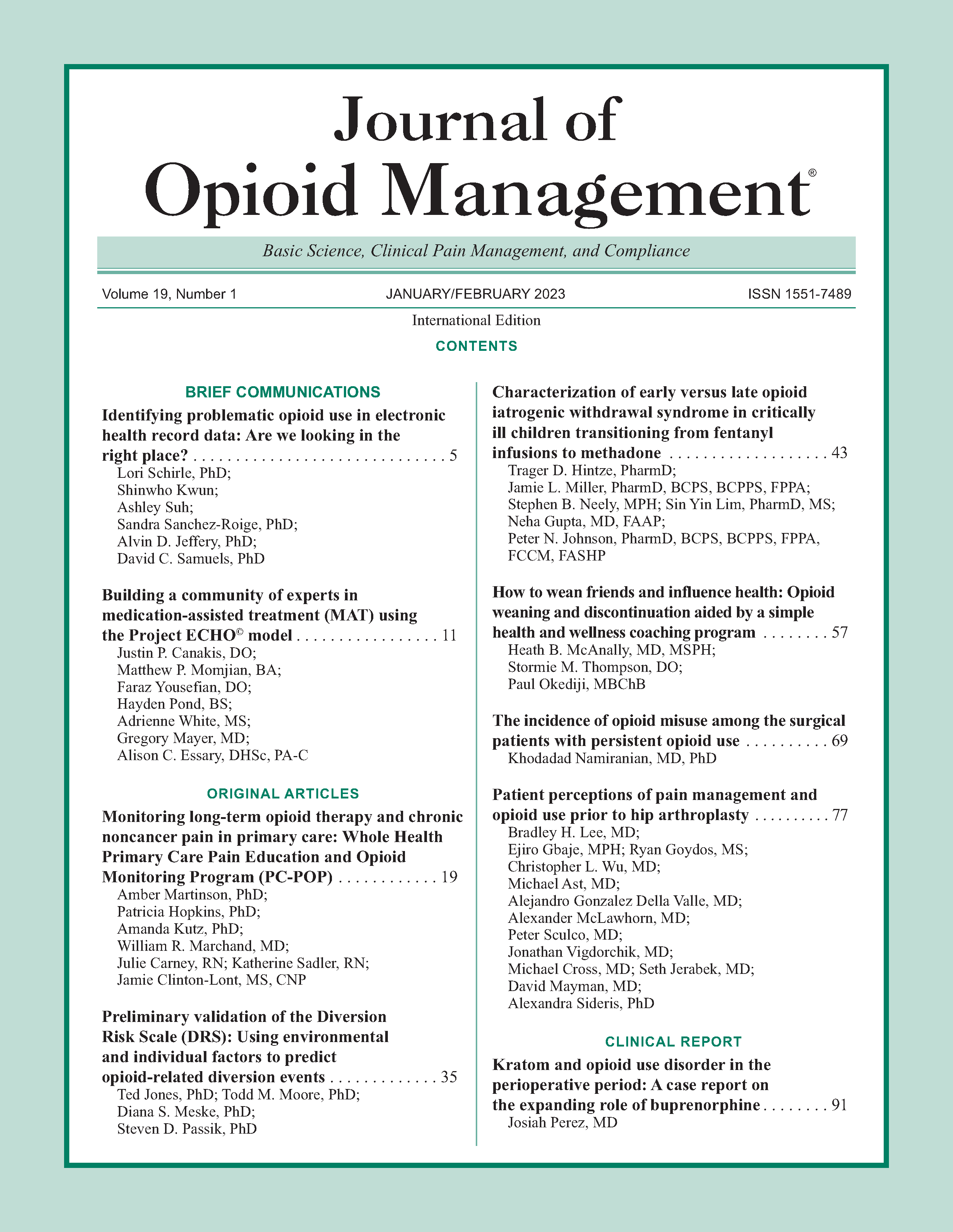Building a community of experts in medication-assisted treatment (MAT) using the Project ECHO© model
DOI:
https://doi.org/10.5055/jom.2023.0755Keywords:
opioid use disorder (OUD), medication-assisted treatment (MAT), telemedicine, extension for community healthcare outcomes (ECHO©), rural medicineAbstract
Background: Project Extension for Community Healthcare Outcomes (ECHO) utilizes telemedicine to connect a multidisciplinary team of experts with a network of primary care physicians to enable rapid dissemination of evidence-based guidelines and practices at scale. In this study, the Project ECHO model disseminated the Arizona Pain and Addiction Curriculum to providers in rural Arizona with the goal to educate providers on medication-assisted treatment (MAT).
Methods: Participants engaged in biweekly, virtual teleECHO sessions, and post-session surveys were used to collect data on provider satisfaction, self-efficacy, knowledge, barriers to change, and changes in practice behavior.
Results: Between February 2020 and November 2020, the MAT-ECHO program hosted 20 teleECHO sessions (N = 20) with 255 unique participating providers and delivered 877 learning hours. Analysis of a 6-month post-ECHO survey (N = 13) demonstrated that teleECHO sessions had broad geographic outreach. Participants had an average of 12 years of experience, 38 percent held NP/PA professional degrees, and 54 percent practiced in opioid treatment program settings. Assessment of job satisfaction and well-being revealed overall improved satisfaction among the small cohort of nonwaivered respondents (N = 8), except for meeting patient’s needs. MAT-waivered respondents reported no post-session changes.
Conclusions: Data from this study demonstrated that teleECHO sessions were well attended, consisted of a diverse cohort with various degrees, and had broad geographic outreach; hence, the utilization of the teleECHO model has the potential to reach rural providers and subsequently increase the availability and efficacy of MAT in rural America.
References
Data Overview: CDC's response to the opioid overdose epidemic. CDC. 2021. Available at https://www.cdc.gov/opioids/data/index.html. Accessed August 1, 2021.
CDC: Understanding the Epidemic: Drug overdose. CDC Injury Center. 2020. Available at https://www.cdc.gov/drugoverdose/epidemic/index.html. Accessed January 20, 2021.
CDC: Drug overdose deaths up 29.4 percent in 2020. AHA News. Available at https://www.aha.org/news/headline/2021-07-14-cdc-drug-overdose-deaths-294-2020. Accessed August 1, 2021.
National Institute on Drug Abuse: Opioid overdose crisis. 2020. Available at https://www.drugabuse.gov/drug-topics/opioids/opioid-overdose-crisis. Accessed January 20, 2021.
Saitz R, Daaleman TP: Now is the time to address substance use disorders in primary care. Ann Fam Med. 2017; 15(4): 306-308. DOI: 10.1370/afm.2111.
Hargan E: Determination that a Public Health Emergency Exists. Health and Human Services. 2017. Available at https://www.phe.gov/emergency/news/healthactions/phe/Pages/opioids.aspx. Accessed August 1, 2021.
Rasyidi E, Wilkins JN, Danovitch I: Training the next generation of providers in addiction medicine. Psychiatr Clin North Am. 2012; 35(2): 461-480. DOI: 10.1016/j.psc.2012.04.001.
Andraka-Christou B, Capone MJ: A qualitative study comparing physician-reported barriers to treating addiction using buprenorphine and extended-release naltrexone in US office-based practices. Int J Drug Policy. 2018; 54: 9-17. DOI: 10.1016/j.drugpo.2017.11.021.
Kennedy-Hendricks A, Busch SH, McGinty EE, et al.: Primary care physicians’ perspectives on the prescription opioid epidemic. Drug Alcohol Depend. 2016; 165: 61-70. DOI: 10.1016/j.drugalcdep.2016.05.010.
Lee TH, Casalino LP, Fisher ES, et al.: Creating accountable care organizations. N Engl J Med. 2010; 363(15): e23. DOI: 10.1056/NEJMp1009040.
The “Medical Neighborhood”: Integrating primary and specialty care for ambulatory patients | Shared decision making and communication | JAMA internal medicine | JAMA network. Available at https://jamanetwork.com/journals/jamainternalmedicine/article-abstract/1815104?=. Accessed January 20, 2021.
Nguyen TD, Gupta S, Ziedan E, et al.: Assessment of filled buprenorphine prescriptions for opioid use disorder during the coronavirus disease 2019 pandemic. JAMA Intern Med. 2021; 181: 562. DOI: 10.1001/jamainternmed.2020.7497.
CDC: Coronavirus disease 2019. 2020. Available at https://www.cdc.gov/media/releases/2020/p1218-overdose-deathscovid-19.html. Accessed March 23, 2021.
National Institute on Drug Abuse: Arizona: Opioid-involved deaths and related harms. 2020. Available at https://www.drugabuse.gov/drug-topics/opioids/opioid-summaries-by-state/arizona-opioid-involved-deaths-related-harms. Accessed January 20, 2021.
AZDHS: Clinicians—home. Available at https://azdhs.gov/audiences/clinicians/arizona-pain-addiction-curriculum/index.php. Accessed January 20, 2021.
AZDHS: Opioid epidemic. Arizona Department of Health Services. Available at http://www.azdhs.gov/prevention/womens-childrens-health/injury-prevention/opioid-prevention/index.php. Accessed January 20, 2021.
AZDHS: Opioid Action Plan: Opioid Overdose Epidemic Response Report. September 2017. Available at https://www.azdhs.gov/documents/prevention/womens-childrens-health/injury-prevention/opioid-prevention/opioid-action-plan.pdf. Accessed January 20, 2021.
Medication Assisted Treatment: ECHO Institute Programs. Available at https://hsc.unm.edu/echo/institute-programs/mat/. Accessed January 21, 2021.
Komaromy M, Duhigg D, Metcalf A, et al.: Project ECHO (extension for community healthcare outcomes): A new model for educating primary care providers about treatment of substance use disorders. Subst Abuse. 2016; 37(1): 20-24. DOI: 10.1080/08897077.2015.1129388.
Korthuis PT, McCarty D, Weimer M, et al.: Primary care-based models for the treatment of opioid use disorder: A scoping review. Ann Intern Med. 2017; 166(4): 268-278. DOI: 10.7326/M16-2149.
Furlan AD, Zhao J, Voth J, et al.: Evaluation of an innovative tele-education intervention in chronic pain management for primary care clinicians practicing in underserved areas. J Telemed Telecare. 2019; 25(8): 484-492. DOI: 10.1177/1357633X18782090.
USDA: Opioid crisis affects all Americans, rural and urban: Available at https://www.usda.gov/media/blog/2018/01/11/opioidcrisis-affects-all-americans-rural-and-urban. Accessed February 11, 2021.
Published
How to Cite
Issue
Section
License
Copyright 2005-2025, Weston Medical Publishing, LLC and Journal of Opioid Management. All Rights Reserved.











